|
|
Sometimes I come across reports of
famous folks in American history with a Turkish connection. No extensive
research has been done with the following, so the truth is up for grabs.
|
|
|
| CAPTAIN JOHN SMITH (1579-1632; or 1580-1631) |
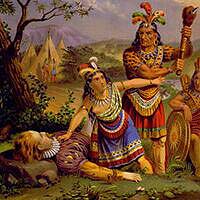 |
|
Don't touch
my paleface! |
The Englishman who was supposedly saved by the love of an Indian
princess wrote a lot about his own life, but many historians trust these personal accounts
about as far as they can be thrown. Before he embarked upon the role of colonist in the
New World that he is best known for, the young adventurer apparently had a yen to do onto
the Terrible Turk. He claims that he went off to battle in Hungary and Transylvania, and
so distinguished himself with daring exploits that a prince of Transylvania (Sigismund
Bathori) presented Smith with a patent of nobility and a pension. After engaging in one
bloody battle too many he was captured and sent as a slave to Istanbul. As we know from
Disney’s POCAHONTAS where he was "portrayed" by Mel Gibson, few women could
resist him, and he captured the heart of his Turkish mistress, a young woman of noble
birth. For some reason, she sent him with a letter confessing her feelings for him, to a
pasha on the Sea of Azov... who happened to be her brother. Resistant to Smith’s charms,
the prince treated Smith none too kindly, until the prisoner beat out the Turk’s brains
with a flail. Like Billy Hayes at the end of MIDNIGHT EXPRESS, Smith put on the dead man's
clothes, and finally reached a Russian garrison.
 |
|
The Cap'n
was quite a charmer... and so clean-shaven! |
Smith also says that he was authorized to wear three Turks' heads in
his arms, in token of three Turks killed by him in a series of remarkable single combats;
"Sigismundus Bathor, Duke of Transilvania, etc.," gave him a patent to that
effect afterward, in December, 1603. However, there is something fishy with Smith’s
account as the Turks were reportedly Sigismund's allies in 1599-1602, and Siggy was not
duke of Transylvania in December, 1603; neither was he king of Hungary, as "writ in
the table" over Smith's tomb. Other accounts of these wars do not mention Smith, and
the accounts furnished by himself are evidently untrustworthy.
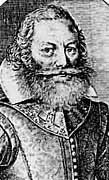 |
|
John Smith:
the reality |
In 1607 Smith would lead a group of colonists in Virginia, only to
be captured by another group of heathen savages. Chief Powhatan was about to do him in,
when history repeated itself as another princess provided the means for escape, this time
with her pleas. (There goes that Indian-Turkish connection,
again. Although many historians question whether this story is actually true.) Contrary to
lore, Pocahontas was only twelve at the time, and as irresistible as Cap’n John Smith
apparently preferred to make himself out to be with the ladies, a romance was likely
nowhere in sight. (Even though the Virginia tourist board would tell us in later years
that Virginia is for lovers.) Pokey picked another white European colonist for a hubby
seven years later, and died shortly afterwards on a trip to England... after exposure to
one of those European diseases she tragically had no resistance to.
|
JOHN PAUL
JONES (1747-1792)
|
A true American hero was this other colonist, the 'Father of the American Navy.'
Born in Scotland, he settled in Virginia; he would become most famous for raiding
the British coast in 1779, in command of a French force. Two British warships would
become toast as a result, after he had just “begun to fight”!
However, one man’s hero is another’s villain, and the English regarded him as a
stinkin' low-down pirate. Early biographer Benjamin Disraeli wrote that the nurses
of Scotland hushed their crying charges by the whisper of his name. (In true
Armenian fashion! “For too many years Armenian mothers had lulled their
children to sleep with songs whose theme was Turkish fierceness and savagery.”
Ohanus Appressian, “Men Are Like
That”)
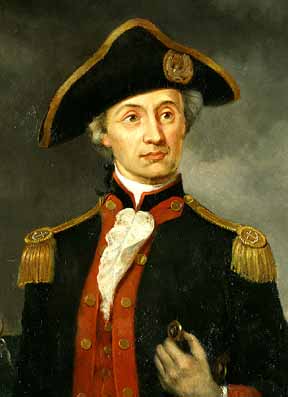 |
|
John
Paul Jones: self-described "Citizen of the World" |
John Paul had a reputation for being a ladies’
man, although not quite the picture of a hunk, described as “slight and wiry in
body, about 5'5" tall with a sharp, wedge shaped nose.” He also had an
explosive temper. A ship’s carpenter accused Jones of having him flogged
mercilessly with the cat o nine tails, wounds that he would die of afterwards.
When Jones returned to Paris during peacetime, American Ambassador Thomas Jefferson
recommended the seaman for service with Russia, and he was subsequently made Rear
Admiral in the Russian Navy (in 1788) by the Empress Catherine II, a rank higher
than he had received in the United States. Jefferson wrote:
You are, I dare say, pleased, as I am, with the promotion of our country-man,
Paul Jones. He commanded the right wing, in the first engagement between the Russian
and Turkish galleys; his absence from the second proves his superiority over the
Captain Pacha, as he did not choose to bring his ships into the shoals in which the
Pacha ventured, and lost those entrusted to him. I consider this officer as the
principal hope of our future efforts on the ocean. You will have heard of the action
between the Swedes and Russians, on the Baltic; as yet, we have only the Swedish
version of it. I apprehend this war must catch from nation to nation, till it
becomes general.
Why did he hook up with the Russians? A writer put it this way (http://www.electricscotland.com/history/other/johnpaul.htm):
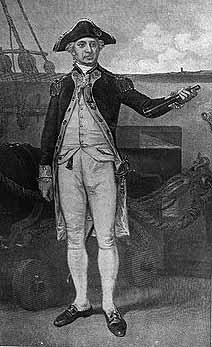 |
|
Avast,
mateys! |
After what he had performed, it would have
been strange if the chevalier Jones had not felt some reluctance to enter into the
service of Russia, where every maxim by which he had been guided during his
exertions for liberty behooved to be reversed, and where, instead of being directed
by the united voice of an intelligent people, he must regulate his conduct by the
single will of a despot. It is one of the greatest evils of despotism, that the
despot, once established, has the means of corrupting and enslaving even the most
generous minds. The chevalier Jones saw many reasons for declining to enter into the
service of Catharine; but, flattered by her attention and kind offers, he thought he
could not do less than to wait upon and thank her in person for her friendly
intentions.
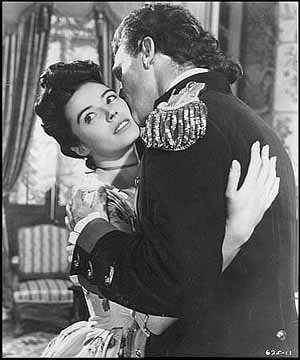 |
|
Robert
Stack slobbers over a landlubber in the 1959 film |
“Though it produced little that is worthy of
the notice of the historian,” the above writer opines, Jones performed well, but
was a victim of jealousy and backbiting (he was falsely accused of molesting a 10
year old daughter of a German immigrant, while living in St. Petersberg) and “disgusted
with the sordid selfishness and the low sensuality that reigned in the court of
Catherine,” he took his leave of Russia in 1789.
What kind of damage did he cause the Turks? Another site reports: “He served with
distinction under Prince Potemkin against the Turks in the Black Sea campaign. At
the Battle of Liman he reconnoitred the Turkish Fleet in a rowboat during the night;
repulsed the Turkish attacks killing about 3000 Turks,destroying 15 vessels and
taking over 1600 prisoners at a cost to his squadron of one frigate and 18 killed.”
If that’s true, it was quite a spectacular victory. A chronology of his Russian
exploits may be found at http://www.history.navy.mil/bios/jones_jp_chron.htm
What could have possessed Jones to hire himself out as he did, to a nation he
probably had little sympathy for? While the above accounts rationalize his decision
as having been somewhat “seduced” by Catherine the Great (who later eulogized
Jones only as a "wrongheaded fellow"), it seems to me naval battle was in
his blood, and the call for action and “glory” proved irresistible to his
fighting ways. Besides, the enemy were only Turks. He probably didn’t have any
idea of the history of the region, and had no reason to feel allegiance to the alien
Russians. Worse, since Jones was likely the type to be fired up by such talk as “Give
me liberty or death” during the American revolution, it seems he completely
sacrificed his freedom-loving principles by aligning himself with a people known for
their brutality and enslavement over others, including even their own. Regardless,
he must have had even less reason to feel sympathy for the vastly more alien,
non-Christian Turks. He didn’t care who he was killing, which doesn’t say much
about his character... since it can’t be said he was fighting for a cause. (An
argument could be made that he was fighting against a cause; the cause of his own
principles.) Whatever little he knew about the Turks, the only thing that was
probably enough for him was that the less-than-human Turks deserved whatever they
got.
|
| |
|
|
The real way in which Americans have fought Turks has been through non-violent
means; even in WWI the USA declined to declare war, mainly to protect missionary
interests. It was through the efforts of missionaries then and the efforts of
Armenians then and now (more Armenians reside in the United States than anywhere
else, after Armenia) that Americans have demonstrated an intense hostility, thanks
to their wholesale acceptance of Armenian propaganda. It is important to keep in
mind there are times the pen can truly be mightier than the sword.
As far as literally
violent means are concerned, Americans and Turks have more often fought on the same
side, as in Korea. Here is what may be the
first recorded instance of when the militaries of both countries cooperated with one
another. ("Part I";
scroll below.)
|
| |
|
|